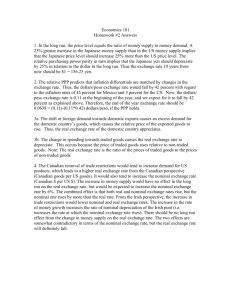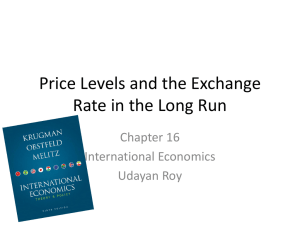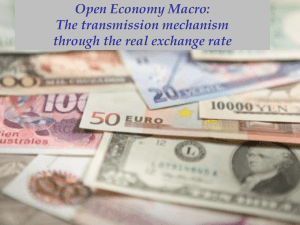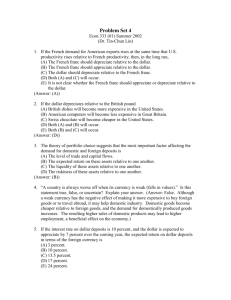Answers to Textbook Problems
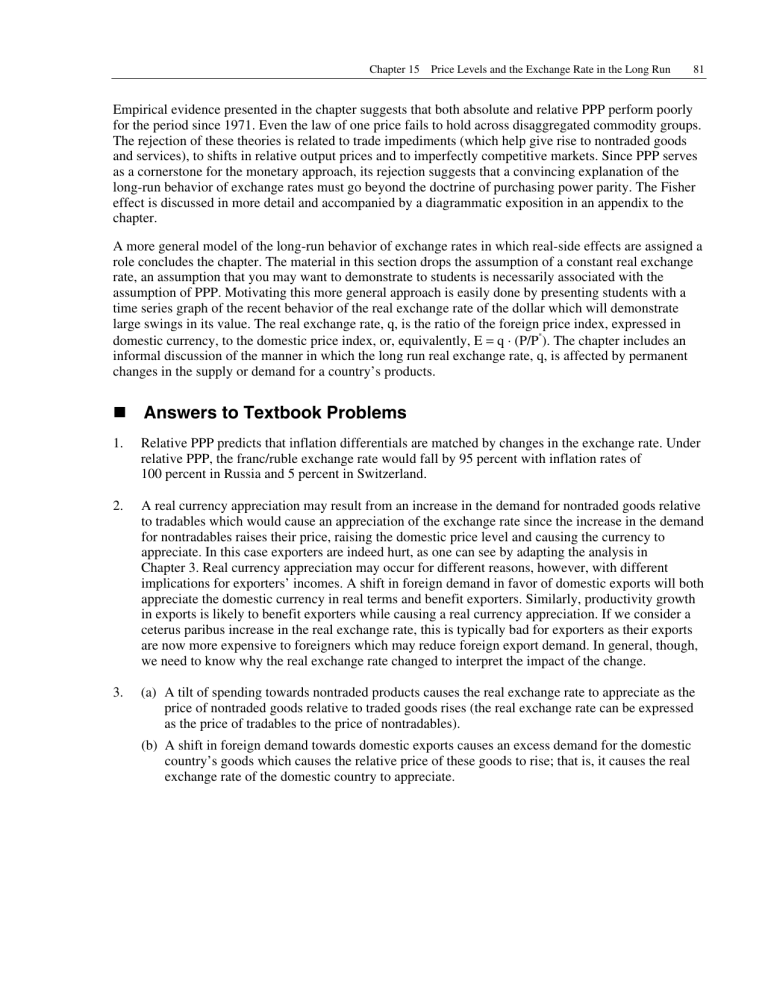
Chapter 15 Price Levels and the Exchange Rate in the Long Run 81
Empirical evidence presented in the chapter suggests that both absolute and relative PPP perform poorly for the period since 1971. Even the law of one price fails to hold across disaggregated commodity groups.
The rejection of these theories is related to trade impediments (which help give rise to nontraded goods and services), to shifts in relative output prices and to imperfectly competitive markets. Since PPP serves as a cornerstone for the monetary approach, its rejection suggests that a convincing explanation of the long-run behavior of exchange rates must go beyond the doctrine of purchasing power parity. The Fisher effect is discussed in more detail and accompanied by a diagrammatic exposition in an appendix to the chapter.
A more general model of the long-run behavior of exchange rates in which real-side effects are assigned a role concludes the chapter. The material in this section drops the assumption of a constant real exchange rate, an assumption that you may want to demonstrate to students is necessarily associated with the assumption of PPP. Motivating this more general approach is easily done by presenting students with a time series graph of the recent behavior of the real exchange rate of the dollar which will demonstrate large swings in its value. The real exchange rate, q, is the ratio of the foreign price index, expressed in domestic currency, to the domestic price index, or, equivalently, E = q · (P/P * ). The chapter includes an informal discussion of the manner in which the long run real exchange rate, q, is affected by permanent changes in the supply or demand for a country’s products.
!
Answers to Textbook Problems
1. Relative PPP predicts that inflation differentials are matched by changes in the exchange rate. Under relative PPP, the franc/ruble exchange rate would fall by 95 percent with inflation rates of
100 percent in Russia and 5 percent in Switzerland.
2. A real currency appreciation may result from an increase in the demand for nontraded goods relative to tradables which would cause an appreciation of the exchange rate since the increase in the demand for nontradables raises their price, raising the domestic price level and causing the currency to appreciate. In this case exporters are indeed hurt, as one can see by adapting the analysis in
Chapter 3. Real currency appreciation may occur for different reasons, however, with different implications for exporters’ incomes. A shift in foreign demand in favor of domestic exports will both appreciate the domestic currency in real terms and benefit exporters. Similarly, productivity growth in exports is likely to benefit exporters while causing a real currency appreciation. If we consider a ceterus paribus increase in the real exchange rate, this is typically bad for exporters as their exports are now more expensive to foreigners which may reduce foreign export demand. In general, though, we need to know why the real exchange rate changed to interpret the impact of the change.
3. (a) A tilt of spending towards nontraded products causes the real exchange rate to appreciate as the price of nontraded goods relative to traded goods rises (the real exchange rate can be expressed as the price of tradables to the price of nontradables).
(b) A shift in foreign demand towards domestic exports causes an excess demand for the domestic country’s goods which causes the relative price of these goods to rise; that is, it causes the real exchange rate of the domestic country to appreciate.
82 Krugman/Obstfeld • International Economics: Theory and Policy, Seventh Edition
4. Relative PPP implies that the pound/dollar exchange rate should be adjusted to offset the inflation difference between the United States and Britain during the war. Thus, a central banker might compare the consumer price indices in the United States and the U.K. before and after the war. If
America’s price level had risen by 10 percent while that in Britain had risen by 20 percent, relative
PPP would call for a pound/dollar exchange rate 10 percent higher than before the war—a 10 percent depreciation of the pound against the dollar.
A comparison based only on PPP would fall short of the task at hand, however, if it ignored possible changes in productivity, productive capacity or in relative demands for goods produced in different countries in wake of the war. In general, one would expect large structural upheavals as a consequence of the war. For example, Britain’s productivity might have fallen dramatically as a result of converting factories to wartime uses (and as a result of bombing). This would call for a real depreciation of the pound, that is, a postwar pound/dollar exchange rate more than 10% higher than the prewar rate.
5. The real effective exchange rate series for Britain shows an appreciation of the pound from 1977 to
1981, followed by a period of depreciation. Note that the appreciation is sharpest after the increase in oil prices starts in early 1979; the subsequent depreciation is steepest after oil prices soften in 1982.
An increase in oil prices increases the incomes received by British oil exporters, raising their demand for goods. The supply response of labor moving into the oil sector is comparable to an increase in productivity which also causes the real exchange rate to appreciate. Of course, a fall in the price of oil has opposite effects. (Oil is not the only factor behind the behavior of the pound’s real exchange rate. Instructors may wish to mention the influence of Prime Minister Margaret
Thatcher’s stringent monetary policies.)
6. The announcement puzzle is that interest rates rise when the market learns money supply growth has been higher than expected (and fall in the opposite case), in contrast to what a simple money-market equilibrium analysis might seem to suggest. Were this phenomenon due to higher expected inflation, we would expect to see the dollar depreciate against foreign currencies, since the expectation of future currency depreciation is one result of higher expected inflation. As demonstrated in the previous chapter, a depreciation of the expected future exchange rate causes the spot rate today to depreciate. If, however, nominal rates are higher because the market expects the Fed to adjust for excessive money growth by tightening, then the higher nominal interest rates reflect a decrease in money supply as banks adjust for expected lower high-powered money in the future. In this case, we would expect to see an appreciation of the currency. Thus, the foreign exchange market can help us distinguish between the two competing explanations for the phenomenon. In fact, Engel and Frankel found that in the early 1980s, the dollar tended to appreciate after unexpectedly high monetary growth was announced and depreciate in the opposite case. This implies expectations regarding Fed action are the likely cause of the increase in nominal interest rates.
7. A permanent shift in the real money demand function will alter the long-run equilibrium nominal exchange rate, but not the long-run equilibrium real exchange rate. Since the real exchange rate does not change, we can use the monetary approach equation, E = (M/M * ) ⋅ {L(R * ,Y * )/L(R,Y)}. A permanent increase in money demand at any nominal interest rate leads to a proportional appreciation of the long-run nominal exchange rate. Intuitively, the level of prices for any level of nominal balances must be lower in the long run for money market equilibrium. The reverse holds for a permanent decrease in money demand. The real exchange rate, however, depends upon relative prices and productivity terms which are not affected by general price-level changes.
Chapter 15 Price Levels and the Exchange Rate in the Long Run 83
8. The mechanism would work through expenditure effects with a permanent transfer from Poland to
The Czech Republic appreciating the zloty (Czech currency) in real terms against the koruna (Polish currency) if (as is reasonable to assume) the Czechs spent a higher proportion of their income on
Czech goods relative to Polish goods than did the Poles.
9. As discussed in the answer to question 8, the zloty appreciates against the koruna in real terms with the transfer from Poland to The Czech Republic if the Czechs spend a higher proportion of their income on Czech goods relative to Polish goods than did the Poles. The real appreciation would lead to a nominal appreciation as well.
10. Since the tariff shifts demand away from foreign exports and toward domestic goods, there is a longrun real appreciation of the home currency. Absent changes in monetary conditions, there is a longrun nominal appreciation as well.
11. The balanced expansion in domestic spending will increase the amount of imports consumed in the country that has a tariff in place, but imports cannot rise in the country that has a quota in place.
Thus, in the country with the quota, there would be an excess demand for imports if the real exchange rate appreciated by the same amount as in the country with tariffs. Therefore, the real exchange rate in the country with a quota must appreciate by less than in the country with the tariff.
12. A permanent increase in the expected rate of real depreciation of the dollar against the euro leads to a permanent increase in the expected rate of depreciation of the nominal dollar/euro exchange rate, given the differential in expected inflation rates across the US and Europe. This increase in the expected depreciation of the dollar causes the spot rate today to depreciate.
13. Suppose there is a temporary fall in the real exchange rate in an economy, that is the exchange rate appreciates today and then will depreciate back to its original level in the future. The expected depreciation of the real exchange rate, by real interest parity, causes the real interest rate to rise. If there is no change in the expected inflation rate then the nominal interest rate rises with the rise in the real exchange rate. This event may also cause the nominal exchange rate to appreciate if the effect of a current appreciation of the real exchange rate dominates the effect of the expected depreciation of the real exchange rate.
14. International differences in expected real interest rates reflect expected changes in real exchange rates. If the expected real interest rate in the United States is 9 percent and the expected real interest rate in Europe is 3 percent then there is an expectation that the real dollar/euro exchange rate will depreciate by 6 percent (assuming that interest parity holds).
15. The initial effect of a reduction in the money supply in a model with sticky prices is an increase in the nominal interest rate and an appreciation of the nominal exchange rate. The real interest rate, which equals the nominal interest rate minus expected inflation, rises by more than the nominal interest rate since the reduction in the money supply causes the nominal interest rate to rise and deflation occurs during the transition to the new equilibrium. The real exchange rate depreciates during the transition to the new equilibrium (where its value is the same as in the original state).
This satisfies the real interest parity relationship which states that the difference between the domestic and the foreign real interest rate equals the expected depreciation of the domestic real exchange rate—in this case, the initial effect is an increase in the real interest rate in the domestic economy coupled with an expected depreciation of the domestic real exchange rate. In any event, the real interest parity relationship must be satisfied since it is simply a restatement of the Fisher equation, which defines the real interest rate, combined with the interest parity relationship, which is a cornerstone of the sticky-price model of the determination of the exchange rate.
84 Krugman/Obstfeld • International Economics: Theory and Policy, Seventh Edition
16. One answer to this question involves the comparison of a sticky-price with a flexible-price model. In a model with sticky prices, a reduction in the money supply causes the nominal interest rate to rise and, by the interest parity relationship, the nominal exchange rate to appreciate. The real interest rate, which equals the nominal interest rate minus expected inflation, increases both because of the increase in the nominal interest rate and because there is expected deflation. In a model with perfectly flexible prices, an increase in expected inflation causes the nominal interest rate to increase
(while the real interest rate remains unchanged) and the currency to depreciate since excess money supply is resolved through an increase in the price level and thus, by PPP, a depreciation of the currency.
An alternative approach is to consider a model with perfectly flexible prices. As discussed in the preceding paragraph, an increase in expected inflation causes the nominal interest rate to increase and the currency to depreciate, leaving the expected real interest rate unchanged. If there is an increase in the expected real interest rate, however, this implies an expected depreciation of the real exchange rate. If this expected depreciation is due to a current, temporary appreciation, then the nominal exchange rate may appreciate if the effect of the current appreciation (which rotates the exchange rate schedule downward) dominates the effect due to the expected depreciation (which rotates the exchange rate schedule in the upwards).
17. If long term rates are higher than short term rates, it suggests that investors expect interest rates to be higher in the future, that is why they demand a higher rate of return on a longer bond. If they expect interest rates to be higher in the future, they are either predicting higher inflation in the future or a higher real interest rate. We cannot tell which by simply looking at short and long rates.
18. If we assume that the real exchange rate is constant, then the expected percentage change in the exchange rate is simply the inflation differential. As the question notes, this relationship holds better over the long run. Starting from interest parity, we see that R exchange rate is π – π
π * . This means r = r *
*
= R * + % ∆ e E. The change in the
when PPP holds, so if PPP holds over a horizon, we can say that R = R * + π –
. So, real interest rate differentials at long maturities should be smaller. On the other hand, if the real exchange rate changes or is expected to change, we would say that % ∆
% ∆ e q + π – π * . In that case, there can be a significant wedge between r and r * e E =
. Thus, if PPP does hold over the long run and people predict this (and consequently are not expecting large changes in the real exchange rate) we would expect to see smaller real interest rate differentials at long maturities.
19. If markets are fairly segmented, then temporary moves in exchange rates may lead to wide deviations from PPP even for tradable goods. In the short run, firms may not be able to respond by opening up new trading relationships or distribution channels. On the other hand, if there are persistent deviations from PPP of tradable goods, we would expect firms to try to increase their presence in the high-price market. If they do this, it should reduce prices there and bring prices back towards PPP.
20. PPP for non-tradables would arise if technologies were similar across countries and thus similar prices for goods in the long run would be consistent with competitive markets and similar labor costs. If the labor costs are similar, then (again assuming similar technologies) the costs of nontradables should be similar also. Of course, as the chapter notes, differences in productivity that vary across sector could result in Balassa Samuelson style effects where despite tradables PPP holding, non-tradables are still priced differently across countries.
